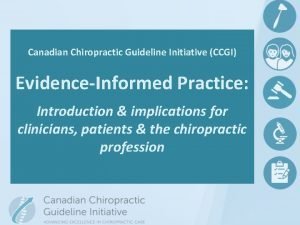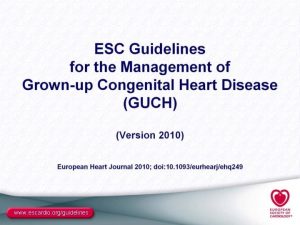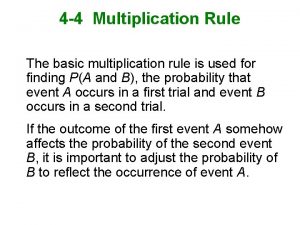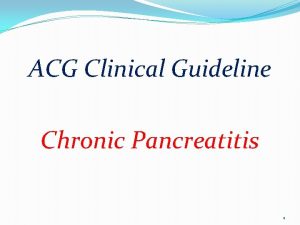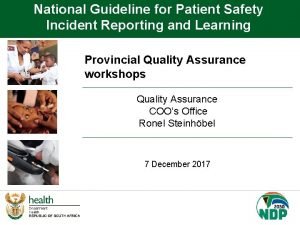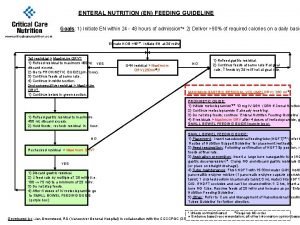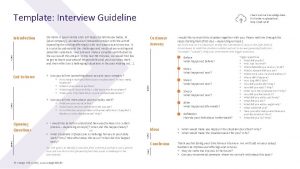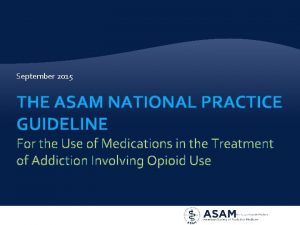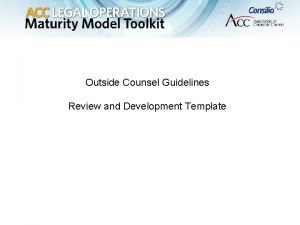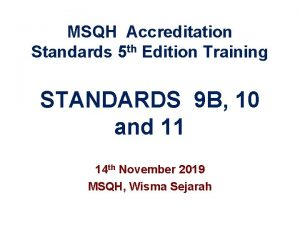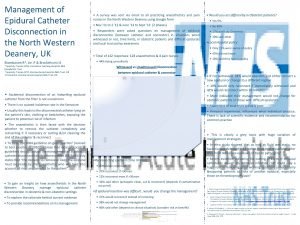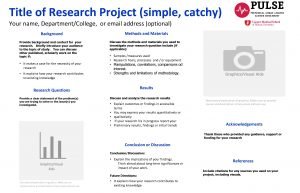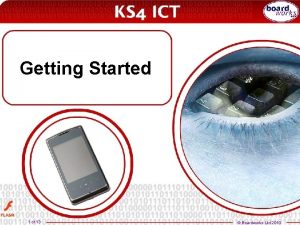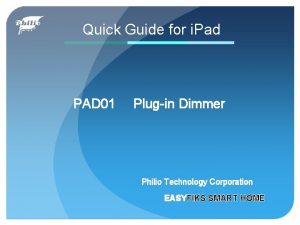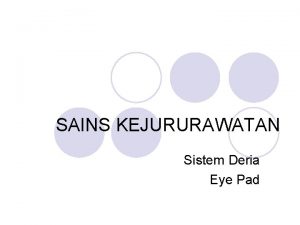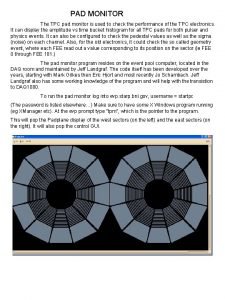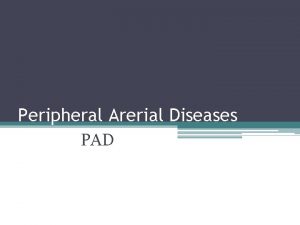PAD Clinical Presentations This guideline recognizes that Individuals





























































- Slides: 61

PAD Clinical Presentations

This guideline recognizes that: Individuals With PAD Present in Clinical Practice With Distinct Syndromes Asymptomatic: Without obvious symptomatic complaint (but usually with a functional impairment). Classic claudication: Lower extremity symptoms confined to the muscles with a consistent (reproducible) onset with exercise and relief with rest. “Atypical” leg pain: Lower extremity discomfort that is exertional but that does not consistently resolve with rest, consistently limit exercise at a reproducible distance, or meet all “Rose questionnaire” criteria.

This guideline recognizes that: Individuals With PAD Present in Clinical Practice With Distinct Syndromes Critical limb lschemia: Ischemic rest pain, nonhealing wound, or gangrene/ Acute limb ischemia: The five “P”s, defined by the clinical symptoms and signs that suggest potential limb jeopardy: - Pain - Pulselessness - Pallor - Paresthesias - Paralysis (& polar, as a sixth “P”).

Clinical Presentations of PAD ~15% Classic (Typical) Claudication 50% Asymptomatic ~33% Atypical Leg Pain (functionally limited) 1%-2% Critical Limb Ischemia

Claudication vs. Pseudoclaudication Characteristic of discomfort Location of discomfort Exercise-induced Distance Occurs with standing Action for relief Time to relief Claudication Pseudoclaudication Cramping, tightness, aching, fatigue Same as claudication plus tingling, burning, numbness Buttock, hip, thigh, calf, foot Same as claudication Yes Variable Consistent Variable No Yes Stand Sit, change position <5 minutes 30 minutes Also see Table 4 of Hirsch AT, et al. J Am Coll Cardiol. 2006; 47: e 1 -e 192.

Leg Pain Has a Differential Diagnosis • Spinal canal stenosis • Peripheral neuropathy • Peripheral nerve pain – Herniated disc impinging on sciatic nerve • • • Osteoarthritis of the hip or knee Venous claudication Symptomatic Baker’s cyst Chronic compartment syndrome Muscle spasms or cramps Restless leg syndrome Also see Table 3 of Hirsch AT, et al. J Am Coll Cardiol. 2006; 47: e 1 -e 192.

ABI and Functional Outcomes Proportion Stopping During 6 -Minute Walk 70 Mean Distance Achieved in 6 -Minute Walk 50 1600 40 1200 ABI=ankle-brachial index -1. 5 1. 1 -1. 1 0. 9 -0. 9 0. 7 0. 5 5 -1. 2 1. 2 -1. 1 1. 1 -1. 0 1. 0 -1. 9 0. 9 -0. 0. 8 -0. 0. 7 -0. 6 0. 6 -0. 0. 5 -0. 0. 4 8 0 7 0 5 400. 4 10 -0. 7 800 . 5 20 <0 Feet 30 <0 Patients (%) 60 ABI Mc. Dermott MM, et al. Ann Intern Med. 2002; 136: 873 -883.

Factors That Increase Risk of Limb Loss in Patients With Critical Limb Ischemia • Factors that reduce blood flow to the microvascular bed - Diabetes - Severe renal failure - Severely decreased cardiac output (severe heart failure or shock) - Vasospastic diseases or concomitant conditions (e. g. , Raynaud’s • - phenomenon, prolonged cold exposure) Smoking and tobacco use Factors that increase demand for blood flow to the microvascular bed - Infection (e. g. , cellulitis, osteomyelitis) - Skin breakdown or traumatic injury Also see Table 5 of Hirsch AT, et al. J Am Coll Cardiol. 2006; 47: e 1 -e 192.

Objectives for Diagnostic Evaluation of Patients With Critical Limb Ischemia • • • Localization of the responsible lesion(s) and measurement of relative severity Assessment of the hemodynamic requirements for successful revascularization (vis-à-vis proximal versus combined revascularization of multilevel disease) Assessment of individual patient endovascular or operative risk Also see Table 6 of Hirsch AT, et al. J Am Coll Cardiol. 2006; 47: e 1 -e 192.

Differential Diagnosis of Common Foot Ulcers Neuropathic Ulcer Neuroischemic Ulcer Painless Painful Normal pulses Absent pulses Typically punches-out appearance Irregular margins Often located on sole or edge of foot or metatarsal head Commonly located on toes Presence of calluses Calluses absent or infrequent Loss of sensation, reflexes, and vibration sense Variable sensory findings Increase in blood flow (arteriovenous shunting) Decrease in blood flow Dilated veins Collapsed veins Dry, warm foot Cold foot Bone deformities No bony deformities Red appearance Pale, cyanotic Reprinted with permission from Dormandy JA, Rutherford RB. J Vasc Surg. 2000; 31: S 1 -S 296.

Etiologic Classification of Foot and Leg Ulcers • • Venous obstruction and insufficiency Arterial etiologies - Larger arteries - Atherosclerotic lower extremity - PAD Thromboemboli, atheroemboli Thromboangiitis obliterans Microcirculatory - Diabetic microangiopathy - Vasculitis - Collagen vascular diseases • Infectious - Leprosy Mycotic • Hematologic • Malignancy • Artifactual or factitious - Sickle cell anemia - Polycythemia - Thrombocytosis - Squamous cell carcinoma - Kaposi’s sarcoma Neuropathic - Diabetes mellitus Also see Table 10 of Hirsch AT, et al. J Am Coll Cardiol. 2006; 47: e 1 -e 192.

The Vascular History and Physical Examination I IIa IIb III Individuals at risk for lower extremity PAD should undergo a vascular review of symptoms to assess walking impairment, claudication, ischemic rest pain, and/or the presence of nonhealing wounds. Individuals at risk for lower extremity PAD should undergo comprehensive pulse examination and inspection of the feet.

Identification of the Asymptomatic Patient With PAD I IIa IIb III A history of walking impairment, claudication, and ischemic rest pain is recommended as a required component of a standard review of systems for adults >50 years who have atherosclerosis risk factors, or for adults >70 years. I IIa IIb III Individuals with asymptomatic PAD should be identified in order to offer therapeutic interventions known to diminish their increased risk of myocardial infarction, stroke, and death.

Identification of the Symptomatic Patient With Intermittent Claudication I IIa IIb III Patients with symptoms of intermittent claudication should undergo a vascular physical examination, including measurement of the ABI. In patients with symptoms of intermittent claudication, the ABI should be measured after exercise if the resting index is normal.

Identification of the Symptomatic Patient With Intermittent Claudication I IIa IIb III Patients with intermittent claudication should have significant functional impairment with a reasonable likelihood of symptomatic improvement and absence of other disease that would comparably limit exercise even if the claudication was improved (e. g. , angina, heart failure, chronic respiratory disease, or orthopedic limitations) before undergoing an evaluation for revascularization.

Revascularization of the Patient With Intermittent Claudication I IIa IIb III Individuals with intermittent claudication who are offered the option of endovascular or surgical therapies should: • be provided information regarding supervised claudication exercise therapy and pharmacotherapy; • receive comprehensive risk factor modification and antiplatelet therapy; • have a significant disability, either being unable to perform normal work or having serious impairment of other activities important to the patient; • have lower extremity PAD lesion anatomy such that the revascularization procedure would have low risk and a high probability of initial and longterm success.

Evaluation of the Patient With Critical Limb Ischemia I IIa IIb III Patients with CLI should undergo expedited evaluation and treatment of factors that are known to increase the risk of amputation. Patients with CLI in whom open surgical repair is anticipated should undergo assessment of cardiovascular risk.

Evaluation of the Patient With Critical Limb Ischemia I IIa IIb III Patients at risk of CLI (ABI less than 0. 4 in a nondiabetic individual, or any diabetic individual with known lower extremity PAD) should undergo regular inspection of the feet to detect objective signs of CLI. The feet should be examined directly, with shoes and socks removed, at regular intervals after successful treatment of CLI.

Evaluation of the Patient With Critical Limb Ischemia I IIa IIb III Patients with CLI and skin breakdown should be referred to healthcare providers with specialized expertise in wound care. I IIa IIb III Patients at risk for CLI (those with diabetes, neuropathy, chronic renal failure, or infection) who develop acute limb symptoms represent potential vascular emergencies and should be assessed immediately and treated by a specialist competent in treating vascular disease.

Surveillance of the Patient With Prior Infra-inguinal Bypass Graft I IIa IIb III Long-term patency of infrainguinal bypass grafts should be evaluated in a surveillance program, which should include an interval vascular history, resting ABIs, physical examination, and a Duplex ultrasound at regular intervals if a venous conduit has been used.

The Clinical Approach to the Patient With, or at Risk for, PAD Clinicians who care for individuals with PAD should be able to provide: • A vascular review of symptoms • A vascular-focused physical examination • Use of the noninvasive vascular diagnostic laboratory (ABI and toe-brachial index [TBI], exercise ABI, Duplex ultrasound, magnetic resonance angiography [MRA], and computed tomographic angiography [CTA]) • When required, use of diagnostic catheterbased angiography

The Vascular Review of Symptoms: An Essential Component of the Vascular History • • • Key components of the vascular review of systems (not usually included in the review of systems of the extremities) and family history include the following: Any exertional limitation of the lower extremity muscles or any history of walking impairment. The characteristics of this limitation may be described as fatigue, aching, numbness, or pain. The primary site(s) of discomfort in the buttock, thigh, calf, or foot should be recorded, along with the relation of such discomfort to rest or exertion. Any poorly healing or nonhealing wounds of the legs or feet. Any pain at rest localized to the lower leg or foot and its association with the upright or recumbent positions. Post-prandial abdominal pain that reproducibly is provoked by eating and is associated with weight loss. Family history of a first-degree relative with an abdominal aortic aneurysm.

Comprehensive Vascular Examination Key components of the vascular physical examination include: • Bilateral arm blood pressure (BP) • Cardiac examination • Palpation of the abdomen for aneurysmal disease • Auscultation for bruits • Examination of legs and feet • Pulse Examination – – – Carotid Radial/ulnar Femoral Popliteal Dorsalis pedis Posterior tibial • Scale: – – 0=Absent 1=Diminished 2=Normal 3=Bounding (aneurysm or AI)

The First Tool to Establish the PAD Diagnosis: A Standardized Physical Examination Pulse intensity should be assessed and should be recorded numerically as follows: – 0, absent – 1, diminished – 2, normal – 3, bounding Use of a standard examination should facilitate clinical communication I IIa IIb III

Differential Diagnosis of PAD • • • Atherosclerosis Vasculitis Fibromuscular dysplasia Atheroembolic disease Thrombotic disorders Trauma Radiation Popliteal aneurysm Thromboangiitis obliterans (Buerger’s disease) • • Popliteal entrapment Cystic adventitial disease Coarctation of aorta Vascular tumor Iliac syndrome of the cyclist Pseudoxanthoma elasticum Persistent sciatic artery (thrombosed)

ACC/AHA Guideline for the Management of PAD: Steps Toward the Diagnosis of PAD Recognizing the “at risk” groups leads to recognition of the five main PAD clinical syndromes: Obtain history of walking impairment and/or limb ischemic symptoms: Obtain a vascular review of symptoms: • Leg discomfort with exertion • Leg pain at rest; non-healing wound; gangrene No leg pain “Atypical” leg pain Classic claudicatio n Chronic critical limb ischemia (CLI) Acute limb ischemia (ALI) Perform a resting ankle-brachial index measurement

How to Perform an ABI Exam • Performed with the patient resting in the supine position • All pressures are measured with an arterial Doppler and appropriately sized blood pressure cuff (edge 1 -2 inches above the pulse; cuff width should be 40% of limb circumference). • Systolic pressures will be measured in the right and left brachial arteries followed by the right and left ankle arteries.

ABI Procedure • Step 1: Apply the appropriately sized blood pressure cuff on the arm above the elbow (either arm). • Step 2: Apply Doppler gel to skin surface. • Step 3: Turn on the Doppler and place the probe in the area of the pulse at a 45 -60° angle to the surface of the skin, pointing to the shoulder. • Step 4: Move the probe around until the clearest arterial signal is heard.

ABI Procedure http: //www. nhlbi. nih. gov/health/dci/Diseases/pad_diagnosis. html

ABI Procedure • Step 5: Inflate the blood pressure cuff to approximately 20 mm. Hg above the point where systolic sounds are no longer heard. • Step 6: Gradually deflate until the arterial signal returns. Record the pressure reading. • Step 7: Repeat the procedure for the right and left posterior tibial and dorsalis pedis arteries. Place the probe on the pulse and angle the probe at 45 o toward the knee. • Step 8: Record the systolic blood pressure of the contralateral arm.

Understanding the ABI The ratio of the higher brachial systolic pressure and the higher ankle systolic pressure for each leg: Ankle systolic pressure ABI = Higher brachial artery systolic pressure

Calculate the ABI 1. For the left side, divide the left ankle pressure by the highest brachial pressure and record the result. 2. Repeat the steps for the right side. 3. Record the ABIs and place the results in the medical record. Right Leg ABI Right Ankle Pressure Highest Arm Pressure Left Leg ABI Left Ankle Pressure Highest Arm Pressure ABI Interpretation ≤ 0. 90 is diagnostic of peripheral arterial disease Hiatt WR. N Engl J Med. 2001; 344: 1608 -1621; TASC Working Group. J Vasc Surg. 2000; 31(1 Suppl): S 1 -S 296.

The Ankle-Brachial Index ABI = Lower extremity systolic pressure Brachial artery systolic pressure • The ankle-brachial index is 95% sensitive and 99% specific for • • • PAD Establishes the PAD diagnosis Identifies a population at high risk of CV ischemic events The “population risk” be clinically epidemiologically ØAge less than 50 at years withcan diabetes, and one and additional defined: risk factor Age 50 to 69 years and history of smoking or diabetes ØAge 70 years and older ØLeg symptoms with exertion (suggestive of claudication) or ischemic rest pain ØAbnormal lower extremity pulse examination ØKnown atherosclerotic coronary, carotid, or renal artery disease • Toe-brachial index (TBI) useful in individuals with non-compressible pedal. Lijmer pulses JG. Ultrasound Med Biol 1996; 22: 391 -8; Feigelson HS. Am J Epidemiol 1994; 140: 526 -34; Baker JD. Surgery 1981; 89: 134 -7; Ouriel K. Arch Surg 1982; 117: 1297 -13; Carter SA. J Vasc Surg 2001; 33: 708 -14

Interpreting the Ankle-Brachial Index ABI 1. 00– 1. 29 Interpretation Normal 0. 91– 0. 99 Borderline 0. 41– 0. 90 Mild-to-moderate disease ≤ 0. 40 Severe disease ≥ 1. 30 Noncompressible Adapted from Hirsch AT, et al. J Am Coll Cardiol. 2006; 47: e 1 -e 192. Figure 6.

Using the ABI: An Example Right ABI 80/160=0. 50 Left ABI 120/160=0. 75 ABI (Normal >0. 90) Brachial SBP 150 mm Hg Brachial SBP 160 mm Hg Highest brachial SBP PT SBP 40 mm Hg DP SBP 80 mm Hg PT SBP 120 mm Hg DP SBP 80 mm Hg Highest of PT or DP SBP ABI=ankle-brachial index; DP=dorsalis pedis; PT=posterior tibial; SBP=systolic blood pressure.

ABI Limitations • Incompressible arteries (elderly patients, patients with diabetes, renal failure, etc. ) • Resting ABI may be insensitive for detecting mild aorto-iliac occlusive disease • Not designed to define degree of functional limitation • Normal resting values in symptomatic patients may become abnormal after exercise • Note: “Non-compressible” pedal arteries is a physiologic term and such arteries need not be “calcified”

Toe-Brachial Index Measurement • The toe-brachial index (TBI) is calculated by dividing the toe pressure by the higher of the two brachial pressures. • TBI values remain accurate when ABI values are not possible due to non-compressible pedal pulses. • TBI values ≤ 0. 7 are usually considered diagnostic for lower extremity PAD.

Hemodynamic Noninvasive Tests • Resting Ankle-Brachial Index (ABI) • Exercise ABI • Segmental pressure examination Pulse tests volume recordings These • traditional continue to provide a simple, risk-free, and cost-effective approach to establishing the PAD diagnosis as well as to follow PAD status after procedures.

Segmental Pressures (mm Hg) 150 Brachial 150 150 110 146 108 100 62 84 0. 54 ABI 0. 44

Pulse Volume Recordings

Exercise ABI Testing • Confirms the PAD diagnosis • Assesses the functional severity of claudication • May “unmask” PAD when resting the ABI is normal • Aids differentiation of intermittent claudication vs. pseudoclaudication diagnoses

Exercise ABI Testing: Treadmill • Indicated when the ABI is normal or borderline but symptoms are consistent with claudication; • An ABI fall post-exercise supports a PAD diagnosis; • Assesses functional capacity (patient symptoms may be discordant with objective exercise capacity). .

The Plantar Flexion Exercise ABI Benefits: • Reproduces treadmill-derived fall in ABI • Can be performed anywhere • Inexpensive Limitation: • Does not measure functional capacity Reprinted with permission from Mc. Phail, IR et al. J Am Coll Cardiol. 2001; 37: 1381.

Color Duplex Ultrasonography

Arterial Duplex Ultrasound Testing • Duplex ultrasound of the extremities is useful to diagnose anatomic location and degree of stenosis of peripheral artery disease. • Duplex ultrasound is useful to provide surveillance following femoral-popliteal bypass using venous conduit (but not prosthetic grafts). • Duplex ultrasound of the extremities can be used to select candidates for: (a) endovascular intervention (b) surgical bypass, and (c) to select the sites of surgical anastomosis. However, the data that might support use of duplex ultrasound to assess long-term patency of PTA is not robust. PTA=percutaneous transluminal angioplasty.

Noninvasive Imaging Tests Duplex Ultrasound Duplex ultrasound of the extremities is useful to diagnose the anatomic location and degree of stenosis of PAD. Duplex ultrasound is recommended for routine surveillance after femoral-popliteal or femoraltibial-pedal bypass with a venous conduit. Minimum surveillance intervals are approximately 3, 6, and 12 months, and then yearly after graft placement.

Magnetic Resonance Angiography (MRA) • MRA has virtually replaced contrast arteriography for PAD diagnosis • Excellent arterial picture • No ionizing radiation • Noniodine–based intravenous contrast medium rarely causes renal insufficiency or allergic reaction • ~10% of patients cannot utilize MRA because of: - Claustrophobia - Pacemaker/implantable cardioverterdefibrillator - Obesity • Gadolinium use in individuals with an e. GFR <60 m. L/min has been associated with nephrogenic systemic fibrosis (NSF)/nephrogenic fibrosing dermopathy

Noninvasive Imaging Tests Magnetic Resonance Angiography (MRA) MRA of the extremities is useful to diagnose anatomic location and degree of stenosis of PAD. I IIa IIb III MRA of the extremities should be performed with gadolinium enhancement. MRA of the extremities is useful in selecting patients with lower extremity PAD as candidates for endovascular intervention.

Computed Tomographic Angiography (CTA) • Requires iodinated contrast • Requires ionizing radiation • Produces an excellent arterial picture

Computed Tomographic Angiography (CTA) • Requires iodinated contrast • Requires ionizing radiation • Produces an excellent arterial picture

Noninvasive Imaging Tests Computed Tomographic Angiography (CTA) CTA of the extremities may be considered to diagnose anatomic location and presence of significant stenosis in patients with lower extremity PAD. CTA of the extremities may be considered as a substitute for MRA for those patients with contraindications to MRA.

The PAD Guideline Provides Steps Toward Ideal PAD Care Take strides to improve the standard of PAD care …

ACC/AHA Guideline for the Management of PAD: Steps Toward the Diagnosis of PAD Individuals “at risk” for PAD Age 50 to 69 years and history of smoking or diabetes Age ≥ 70 years Abnormal lower extremity pulse examination Known atherosclerotic coronary, carotid, or renal arterial disease Obtain history of walking impairment and/or limb ischemic symptoms: Obtain a vascular review of symptoms: • Leg discomfort with exertion • Leg pain at rest; nonhealing wound; gangrene No leg pain “Atypical” leg pain Classic claudicatio n Chronic critical limb ischemia (CLI) Acute limb ischemia (ALI) Perform a resting ankle-brachial index measurement Diagnosis and Treatment of Asymptomatic PAD and Atypical Leg Pain Diagnosis and Treatment of Claudication Diagnosis and Treatment of Critical Limb Ischemia Diagnosis and Treatment of Acute Limb Ischemia Hirsch AT, et al. J Am Coll Cardiol. 2006; 47: e 1 -e 192.

ACC/AHA Guideline for the Management of PAD: Diagnosis and Treatment of Asymptomatic PAD Individual at PAD risk: No leg symptoms or atypical leg symptoms Consider use of the San Diego Walking Impairment Questionnaire Perform a resting ankle-brachial index measurement ABI ≥ 1. 30 (abnormal) ABI 0. 91 to 1. 30 (borderline & normal) Pulse volume recording Toe-brachial index (Duplex ultrasonography) Measure ABI after exercise test Normal results: No PAD Abnormal results Normal post-exercise ABI: No PAD ABI ≤ 0. 90 (abnormal) Decreased post-exercise ABI Confirmation of PAD diagnosis Evaluate other causes of leg symptoms Hirsch AT, et al. J Am Coll Cardiol. 2006; 47: e 1 -e 192.

ACC/AHA Guideline for the Management of PAD: Diagnosis and Treatment of Asymptomatic PAD Confirmation of PAD diagnosis Risk factor normalization: Immediate smoking cessation Treat hypertension: JNC-7 guidelines Treat lipids: NCEP ATP III guidelines Treat diabetes mellitus: Hb. A 1 c less than 7% Pharmacological Risk Reduction: Antiplatelet therapy (ACE inhibition; Class IIb, LOE C) ACE=angiotensin-converting enzyme; JNC-7=Joint National Committee on Prevention ; NCEP=National Cholesterol Education Program – Adult Treatment Panel III. Hirsch AT, et al. J Am Coll Cardiol. 2006; 47: e 1 -e 192.

ACC/AHA Guideline for the Management of PAD: Diagnosis of Claudication and Systemic Risk Treatment Classic Claudication Symptoms: Muscle fatigue, cramping, or pain that reproducibly begins during exercise and that promptly resolves with rest Chart document the history of walking impairment (pain-free and total walking distance) and specific lifestyle limitations Document pulse examination ABI greater than 0. 90 ABI less than or equal to 0. 90 Confirmed PAD diagnosis Cont’d ABI=ankle-brachial index; TBI=toe-brachial index. Exercise ABI (TBI, segmental pressure, or Duplex ultrasound examination) Abnorma l results Normal results No PAD or consider arterial entrapment syndromes Hirsch AT, et al. J Am Coll Cardiol. 2006; 47: e 1 -e 192.

ACC/AHA Guideline for the Management of PAD: Diagnosis of Claudication and Systemic Risk Treatment Confirmed PAD diagnosis Risk factor normalization: Immediate smoking cessation Treat hypertension: JNC-7 guidelines Treat lipids: NCEP ATP III guidelines Treat diabetes mellitus: Hb. A 1 c less than 7% Pharmacological risk reduction: Antiplatelet therapy (ACE inhibition; Class IIa) Treatment of Claudication ACE=angiotensin-converting enzyme; JNC-7=Joint National Committee on Prevention ; NCEP=National Cholesterol Education Program – Adult Treatment Panel III. Hirsch AT, et al. J Am Coll Cardiol. 2006; 47: e 1 -e 192.

ACC/AHA Guideline for the Management of PAD: Treatment of Claudication Confirmed PAD Diagnosis Lifestyle-limiting symptoms No significant functional disability • • No claudication treatment required. Follow-up visits at least annually to monitor for development of leg, coronary, or cerebrovascular ischemic symptoms. Supervised exercise program Pharmacological therapy: Cilostazol (Pentoxifylline) Three-month trial Further anatomic definition by more extensive noninvasive or angiographic diagnostic techniques Endovascular therapy or surgical bypass per anatomy Preprogram and postprogram exercise testing for efficacy Clinical improvement: Follow-up visits at least annually Lifestyle-limiting symptoms with evidence of inflow disease Significant disability despite medical therapy and/or inflow endovascular therapy, with documentation of outflow PAD, with favorable procedural anatomy and procedural risk-benefit ratio Evaluation for additional endovascular or surgical revascularization Hirsch AT, et al. J Am Coll Cardiol. 2006; 47: e 1 -e 192.

ACC/AHA Guideline for the Management of PAD: Diagnosis and Treatment of Critical Limb Ischemia Chronic CLI symptoms: Ischemic rest pain, gangrene, nonhealing wound Ischemic etiology must be established promptly by examination and objective vascular studies Implication: Impending limb loss History and physical examination : Document lower extremity pulses; Document presence of ulcers or infection Assess factors that may contribute to limb risk: diabetes, neuropathy, chronic renal failure, infection ABI, TBI, or Duplex US Severe lower extremity PAD documented: ABI less than 0. 4; flat PVR waveform; absent pedal flow Cont’d ABI=ankle-brachial index; CLI=critical limb ischemia; CTA=computed tomographic angiography; ECG=electrocardiogram; MRA=magnetic resonance angiography; PVR=pulse volume recording; TEE=transesophageal echocardiogram; TBI=toe-brachial index; US= ultrasound. No or minimal atherosclerotic arterial occlusive disease Evaluation of source (ECG or Holter monitor; TEE; and/or abdominal US, MRA, or CTA); or venous Duplex Consider atheroembolism, thromboembolism, or phlegmasia cerulea dolens Hirsch AT, et al. J Am Coll Cardiol. 2006; 47: e 1 -e 192.

ACC/AHA Guideline for the Management of PAD: Diagnosis and Treatment of Critical Limb Ischemia (1) Severe lower extremity PAD documented: ABI less than 0. 4; flat PVR waveform; absent pedal flow Systemic antibiotics if skin ulceration and limb infection are present Patient is not a candidate for revascularization Medical therapy or amputation (when necessary) Ongoing vascular surveillance Written instructions for self-surveillance Obtain prompt vascular specialist consultation: • Diagnostic testing strategy • Creation of therapeutic intervention plan Patient is a candidate for revascularization Cont’d ABI=ankle-brachial index; PVR=pulse volume recording. Hirsch AT, et al. J Am Coll Cardiol. 2006; 47: e 1 -e 192.

ACC/AHA Guideline for the Management of PAD: Diagnosis and Treatment of Critical Limb Ischemia (2) Patient is a candidate for revascularization • Define limb arterial anatomy • Assess clinical and objective severity of ischemia Imaging of relevant arterial circulation (noninvasive and angiographic) Revascularization possible (see treatment text, with application of thrombolytic, endovascular, and surgical therapies) Revascularization not possible: medical therapy; amputation (when necessary) Ongoing vascular surveillance Written instructions for self-surveillance Hirsch AT, et al. J Am Coll Cardiol. 2006; 47: e 1 -e 192.
 Acromegaly an endocrine society clinical practice guideline
Acromegaly an endocrine society clinical practice guideline Leischker
Leischker Aki kdigo
Aki kdigo Hãy nói thật ít để làm được nhiều
Hãy nói thật ít để làm được nhiều Thơ thất ngôn tứ tuyệt đường luật
Thơ thất ngôn tứ tuyệt đường luật Tôn thất thuyết là ai
Tôn thất thuyết là ai Ngoại tâm thu thất chùm đôi
Ngoại tâm thu thất chùm đôi Chiến lược kinh doanh quốc tế của walmart
Chiến lược kinh doanh quốc tế của walmart Gây tê cơ vuông thắt lưng
Gây tê cơ vuông thắt lưng Block av độ 2
Block av độ 2 Tìm vết của đường thẳng
Tìm vết của đường thẳng Sau thất bại ở hồ điển triệt
Sau thất bại ở hồ điển triệt Thể thơ truyền thống
Thể thơ truyền thống Analysing consumer market
Analysing consumer market Skyscraper model of culture
Skyscraper model of culture A cultural approach to media recognizes
A cultural approach to media recognizes Applied anthropology's systemic perspective recognizes that
Applied anthropology's systemic perspective recognizes that Anemia in pregnancy guideline
Anemia in pregnancy guideline Srm process flow
Srm process flow Ccgi guidelines
Ccgi guidelines Guideline anamnesa
Guideline anamnesa Escardio guideline
Escardio guideline Formal multiplication rule
Formal multiplication rule What is a guideline for hoisting a hoseline?
What is a guideline for hoisting a hoseline? Autoanamnesa
Autoanamnesa Fmea guideline
Fmea guideline Acg pancreatitis
Acg pancreatitis East practice management guidelines
East practice management guidelines Waikato stormwater management guideline
Waikato stormwater management guideline Asean stability guideline
Asean stability guideline Who guideline on country pharmaceutical pricing policies
Who guideline on country pharmaceutical pricing policies Turnbull guidelines
Turnbull guidelines Patient safety incident report form
Patient safety incident report form Bpfk cosmetic guideline
Bpfk cosmetic guideline Enteral feeding guideline
Enteral feeding guideline Interview guideline template
Interview guideline template Asam national practice guideline
Asam national practice guideline Sample outside counsel guidelines
Sample outside counsel guidelines 5 guideline for cumbersome calculations
5 guideline for cumbersome calculations Msqh guideline
Msqh guideline Disconnected epidural catheter guideline
Disconnected epidural catheter guideline Notching hair
Notching hair Useful phrases presentation
Useful phrases presentation The most dangerous game powerpoint presentations
The most dangerous game powerpoint presentations How to make a tok presentation
How to make a tok presentation Roof ppt presentations
Roof ppt presentations Research project name
Research project name Boardworks presentations
Boardworks presentations Horrible powerpoint presentation
Horrible powerpoint presentation Corel presentations ventajas
Corel presentations ventajas Bad powerpoint presentations examples
Bad powerpoint presentations examples Efficient elements download
Efficient elements download Presentation note cards
Presentation note cards World's worst presentation
World's worst presentation Https://creativemarket.com/
Https://creativemarket.com/ Robotics merit badge answers
Robotics merit badge answers Minto pyramid
Minto pyramid Developing oral and online presentation
Developing oral and online presentation Really bad powerpoint
Really bad powerpoint The end pictures for presentations
The end pictures for presentations You exec plus
You exec plus Business presentations bristol
Business presentations bristol



















